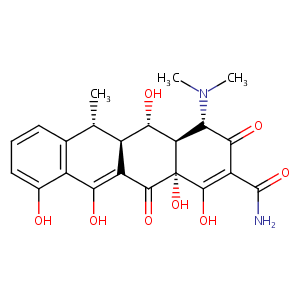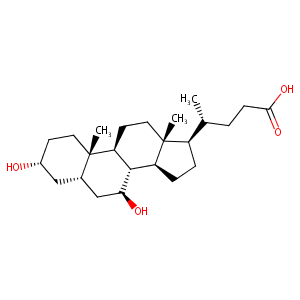| DOT Name |
DOT ID |
UniProt ID |
Mode of Action |
REF |
|
Solute carrier organic anion transporter family member 1B1 (SLCO1B1)
|
OTNEN8QK
|
SO1B1_HUMAN
|
Increases Uptake
|
[21] |
|
Aldo-keto reductase family 1 member C3 (AKR1C3)
|
OTU2SXBA
|
AK1C3_HUMAN
|
Decreases Activity
|
[23] |
|
Aldo-keto reductase family 1 member C2 (AKR1C2)
|
OTQ2XMO3
|
AK1C2_HUMAN
|
Decreases Activity
|
[23] |
|
Aldo-keto reductase family 1 member C1 (AKR1C1)
|
OTQKR4CM
|
AK1C1_HUMAN
|
Decreases Activity
|
[23] |
|
ATP-dependent translocase ABCB1 (ABCB1)
|
OTEJROBO
|
MDR1_HUMAN
|
Increases Expression
|
[24] |
|
Cytochrome P450 3A4 (CYP3A4)
|
OTQGYY83
|
CP3A4_HUMAN
|
Increases Expression
|
[24] |
|
Nuclear receptor subfamily 1 group I member 2 (NR1I2)
|
OTC5U0N5
|
NR1I2_HUMAN
|
Increases Expression
|
[25] |
|
Nuclear receptor subfamily 0 group B member 2 (NR0B2)
|
OT7UVICX
|
NR0B2_HUMAN
|
Increases Expression
|
[25] |
|
Solute carrier family 23 member 2 (SLC23A2)
|
OTJ5CQMA
|
S23A2_HUMAN
|
Increases Expression
|
[25] |
|
Solute carrier family 23 member 1 (SLC23A1)
|
OTE6F9U6
|
S23A1_HUMAN
|
Increases Expression
|
[25] |
|
Stearoyl-CoA desaturase (SCD)
|
OTB1073G
|
SCD_HUMAN
|
Decreases Expression
|
[26] |
|
Tumor necrosis factor receptor superfamily member 10B (TNFRSF10B)
|
OTA1CPBV
|
TR10B_HUMAN
|
Increases Expression
|
[27] |
|
Serine/threonine-protein phosphatase 6 regulatory ankyrin repeat subunit A (ANKRD28)
|
OTRBREQ9
|
ANR28_HUMAN
|
Affects Expression
|
[18] |
|
ATP-binding cassette sub-family C member 3 (ABCC3)
|
OTC3IJV4
|
MRP3_HUMAN
|
Increases Expression
|
[28] |
|
CASP8 and FADD-like apoptosis regulator (CFLAR)
|
OTX14BAS
|
CFLAR_HUMAN
|
Increases Expression
|
[29] |
|
Splicing factor 3B subunit 1 (SF3B1)
|
OTNTX2DG
|
SF3B1_HUMAN
|
Affects Expression
|
[18] |
|
Rho-related BTB domain-containing protein 3 (RHOBTB3)
|
OT1BFKPH
|
RHBT3_HUMAN
|
Affects Expression
|
[18] |
|
Bile salt export pump (ABCB11)
|
OTRU7THO
|
ABCBB_HUMAN
|
Increases Expression
|
[30] |
|
Fibroblast growth factor 19 (FGF19)
|
OT2DVJWY
|
FGF19_HUMAN
|
Increases Expression
|
[28] |
|
HLA class II histocompatibility antigen, DR alpha chain (HLA-DRA)
|
OT7KZMP2
|
DRA_HUMAN
|
Increases Expression
|
[31] |
|
Apolipoprotein A-I (APOA1)
|
OT5THARI
|
APOA1_HUMAN
|
Increases Expression
|
[32] |
|
Fibrinogen gamma chain (FGG)
|
OT5BJSEX
|
FIBG_HUMAN
|
Affects Expression
|
[18] |
|
Myelin basic protein (MBP)
|
OTFZCEDB
|
MBP_HUMAN
|
Affects Expression
|
[18] |
|
C4b-binding protein alpha chain (C4BPA)
|
OTHNH6Y8
|
C4BPA_HUMAN
|
Affects Expression
|
[18] |
|
Glucocorticoid receptor (NR3C1)
|
OTCI2YDI
|
GCR_HUMAN
|
Increases Localization
|
[33] |
|
Cellular tumor antigen p53 (TP53)
|
OTIE1VH3
|
P53_HUMAN
|
Increases Ubiquitination
|
[34] |
|
ADP/ATP translocase 2 (SLC25A5)
|
OT1XIBMN
|
ADT2_HUMAN
|
Affects Expression
|
[18] |
|
Endothelin-1 (EDN1)
|
OTZCACEG
|
EDN1_HUMAN
|
Decreases Expression
|
[35] |
|
Large ribosomal subunit protein P2 (RPLP2)
|
OT2YBK3W
|
RLA2_HUMAN
|
Affects Expression
|
[18] |
|
Protein kinase C beta type (PRKCB)
|
OTYQ0656
|
KPCB_HUMAN
|
Increases Activity
|
[36] |
|
Retinoblastoma-associated protein (RB1)
|
OTQJUJMZ
|
RB_HUMAN
|
Decreases Expression
|
[37] |
|
Involucrin (IVL)
|
OT4VPNGY
|
INVO_HUMAN
|
Decreases Expression
|
[38] |
|
Growth-regulated alpha protein (CXCL1)
|
OT3WCTZV
|
GROA_HUMAN
|
Increases Expression
|
[26] |
|
2',3'-cyclic-nucleotide 3'-phosphodiesterase (CNP)
|
OTB8HCED
|
CN37_HUMAN
|
Affects Expression
|
[18] |
|
Poly polymerase 1 (PARP1)
|
OT310QSG
|
PARP1_HUMAN
|
Increases Cleavage
|
[27] |
|
Apoptosis regulator Bcl-2 (BCL2)
|
OT9DVHC0
|
BCL2_HUMAN
|
Decreases Expression
|
[37] |
|
Dihydrolipoyllysine-residue acetyltransferase component of pyruvate dehydrogenase complex, mitochondrial (DLAT)
|
OT9LBJVN
|
ODP2_HUMAN
|
Affects Expression
|
[18] |
|
Endoplasmic reticulum chaperone BiP (HSPA5)
|
OTFUIRAO
|
BIP_HUMAN
|
Decreases Expression
|
[26] |
|
Inosine-5'-monophosphate dehydrogenase 2 (IMPDH2)
|
OTPG0K7E
|
IMDH2_HUMAN
|
Affects Expression
|
[18] |
|
C-C motif chemokine 2 (CCL2)
|
OTAD2HEL
|
CCL2_HUMAN
|
Increases Expression
|
[26] |
|
Fatty acid-binding protein, adipocyte (FABP4)
|
OT3DKFOU
|
FABP4_HUMAN
|
Decreases Expression
|
[26] |
|
Large ribosomal subunit protein eL33 (RPL35A)
|
OTDDJUWF
|
RL35A_HUMAN
|
Affects Expression
|
[18] |
|
Cyclic AMP-dependent transcription factor ATF-4 (ATF4)
|
OTRFV19J
|
ATF4_HUMAN
|
Decreases Expression
|
[26] |
|
Alpha-1-acid glycoprotein 2 (ORM2)
|
OTRJGZP8
|
A1AG2_HUMAN
|
Affects Expression
|
[18] |
|
Endothelin-2 (EDN2)
|
OTQ7RCPI
|
EDN2_HUMAN
|
Decreases Expression
|
[39] |
|
Cytochrome P450 7A1 (CYP7A1)
|
OT8Z5KLD
|
CP7A1_HUMAN
|
Decreases Expression
|
[30] |
|
G1/S-specific cyclin-D1 (CCND1)
|
OT8HPTKJ
|
CCND1_HUMAN
|
Decreases Expression
|
[37] |
|
Mitogen-activated protein kinase 3 (MAPK3)
|
OTCYKGKO
|
MK03_HUMAN
|
Increases Phosphorylation
|
[26] |
|
Large ribosomal subunit protein uL16 (RPL10)
|
OTBHOZGC
|
RL10_HUMAN
|
Affects Expression
|
[18] |
|
Mitogen-activated protein kinase 1 (MAPK1)
|
OTH85PI5
|
MK01_HUMAN
|
Increases Phosphorylation
|
[26] |
|
G1/S-specific cyclin-D3 (CCND3)
|
OTNKPQ22
|
CCND3_HUMAN
|
Decreases Expression
|
[37] |
|
RAC-alpha serine/threonine-protein kinase (AKT1)
|
OT8H2YY7
|
AKT1_HUMAN
|
Increases Phosphorylation
|
[40] |
|
Intercellular adhesion molecule 3 (ICAM3)
|
OTTZ5A5D
|
ICAM3_HUMAN
|
Affects Expression
|
[18] |
|
Peroxisome proliferator-activated receptor gamma (PPARG)
|
OTHMARHO
|
PPARG_HUMAN
|
Decreases Expression
|
[26] |
|
Glycine--tRNA ligase (GARS1)
|
OT5B6R9Y
|
GARS_HUMAN
|
Affects Expression
|
[18] |
|
Eukaryotic translation initiation factor 1 (EIF1)
|
OTB4GZ0V
|
EIF1_HUMAN
|
Affects Expression
|
[18] |
|
Glutamate--cysteine ligase catalytic subunit (GCLC)
|
OTESDI4D
|
GSH1_HUMAN
|
Increases Expression
|
[40] |
|
Glutamate--cysteine ligase regulatory subunit (GCLM)
|
OT6CP234
|
GSH0_HUMAN
|
Increases Expression
|
[40] |
|
Glutathione synthetase (GSS)
|
OTVSBEIW
|
GSHB_HUMAN
|
Increases Expression
|
[40] |
|
T-complex protein 1 subunit epsilon (CCT5)
|
OTPZ38BT
|
TCPE_HUMAN
|
Affects Expression
|
[18] |
|
Fatty acid synthase (FASN)
|
OTFII9KG
|
FAS_HUMAN
|
Decreases Expression
|
[26] |
|
T-complex protein 1 subunit gamma (CCT3)
|
OTL6EOS1
|
TCPG_HUMAN
|
Affects Expression
|
[18] |
|
Gastrotropin (FABP6)
|
OTIRQWLW
|
FABP6_HUMAN
|
Increases Expression
|
[41] |
|
Small ribosomal subunit protein mS29 (DAP3)
|
OTNPEZYM
|
RT29_HUMAN
|
Affects Expression
|
[18] |
|
Exportin-2 (CSE1L)
|
OTV2X99A
|
XPO2_HUMAN
|
Affects Expression
|
[18] |
|
Nucleosome assembly protein 1-like 1 (NAP1L1)
|
OTI7WBZV
|
NP1L1_HUMAN
|
Affects Expression
|
[18] |
|
Large ribosomal subunit protein eL27 (RPL27)
|
OTWEOUTX
|
RL27_HUMAN
|
Affects Expression
|
[18] |
|
Transforming protein RhoA (RHOA)
|
OT6YOJ9N
|
RHOA_HUMAN
|
Decreases Activity
|
[42] |
|
Small ribosomal subunit protein uS15 (RPS13)
|
OTOMDIJ2
|
RS13_HUMAN
|
Affects Expression
|
[18] |
|
Small ribosomal subunit protein eS28 (RPS28)
|
OT12IES1
|
RS28_HUMAN
|
Affects Expression
|
[18] |
|
Large ribosomal subunit protein eL32 (RPL32)
|
OTKRQJT4
|
RL32_HUMAN
|
Affects Expression
|
[18] |
|
Ras-related C3 botulinum toxin substrate 1 (RAC1)
|
OTKRO61U
|
RAC1_HUMAN
|
Affects Expression
|
[18] |
|
Large ribosomal subunit protein eL6 (RPL6)
|
OTRU71O4
|
RL6_HUMAN
|
Affects Expression
|
[18] |
|
Single-stranded DNA-binding protein, mitochondrial (SSBP1)
|
OTH2PZWH
|
SSBP_HUMAN
|
Affects Expression
|
[18] |
|
Protein kinase C delta type (PRKCD)
|
OTSEH90E
|
KPCD_HUMAN
|
Increases Localization
|
[27] |
|
Apoptosis regulator BAX (BAX)
|
OTAW0V4V
|
BAX_HUMAN
|
Increases Expression
|
[37] |
|
Induced myeloid leukemia cell differentiation protein Mcl-1 (MCL1)
|
OT2YYI1A
|
MCL1_HUMAN
|
Increases Expression
|
[29] |
|
ATP-dependent RNA helicase A (DHX9)
|
OT5AAOQI
|
DHX9_HUMAN
|
Affects Expression
|
[18] |
|
Fibrinogen-like protein 1 (FGL1)
|
OTT0QHQ1
|
FGL1_HUMAN
|
Affects Expression
|
[18] |
|
Serine/threonine-protein kinase 3 (STK3)
|
OTLNSCQD
|
STK3_HUMAN
|
Affects Expression
|
[18] |
|
DnaJ homolog subfamily C member 3 (DNAJC3)
|
OT7ROIJF
|
DNJC3_HUMAN
|
Decreases Expression
|
[26] |
|
Caspase-8 (CASP8)
|
OTA8TVI8
|
CASP8_HUMAN
|
Increases Activity
|
[27] |
|
Nuclear factor erythroid 2-related factor 2 (NFE2L2)
|
OT0HENJ5
|
NF2L2_HUMAN
|
Increases Localization
|
[40] |
|
Protein Smaug homolog 2 (SAMD4B)
|
OTVRZJ5D
|
SMAG2_HUMAN
|
Affects Expression
|
[18] |
|
Chondroitin sulfate proteoglycan 4 (CSPG4)
|
OTW2D6DE
|
CSPG4_HUMAN
|
Affects Expression
|
[18] |
|
Ribosomal protein eS27-like (RPS27L)
|
OTZWHU0N
|
RS27L_HUMAN
|
Affects Expression
|
[18] |
|
Endoplasmic reticulum metallopeptidase 1 (ERMP1)
|
OT9CIEO2
|
ERMP1_HUMAN
|
Affects Expression
|
[18] |
|
E3 ubiquitin-protein ligase RBBP6 (RBBP6)
|
OTTVG4HU
|
RBBP6_HUMAN
|
Affects Expression
|
[18] |
|
Out at first protein homolog (OAF)
|
OTOR9CR5
|
OAF_HUMAN
|
Affects Expression
|
[18] |
|
Organic solute transporter subunit alpha (SLC51A)
|
OTDJRZ0P
|
OSTA_HUMAN
|
Increases Expression
|
[28] |
|
Organic solute transporter subunit beta (SLC51B)
|
OT4WYPSR
|
OSTB_HUMAN
|
Increases Expression
|
[28] |
|
Shieldin complex subunit 2 (SHLD2)
|
OTMLERXL
|
SHLD2_HUMAN
|
Affects Expression
|
[18] |
|
G-protein coupled bile acid receptor 1 (GPBAR1)
|
OT4BKEJ9
|
GPBAR_HUMAN
|
Decreases Expression
|
[26] |
|
E3 ubiquitin-protein ligase rififylin (RFFL)
|
OT85MGDH
|
RFFL_HUMAN
|
Affects Expression
|
[18] |
|
ATP-binding cassette sub-family C member 2 (ABCC2)
|
OTJSIGV5
|
MRP2_HUMAN
|
Increases Expression
|
[43] |
|
AP-2 complex subunit mu (AP2M1)
|
OTQCOSFN
|
AP2M1_HUMAN
|
Affects Expression
|
[18] |
|
Ribosomal protein eL39-like 2 (RPL39L)
|
OTAV1MJQ
|
RL39L_HUMAN
|
Affects Expression
|
[18] |
|
Rho GTPase-activating protein 7 (DLC1)
|
OTP8LMCR
|
RHG07_HUMAN
|
Increases Expression
|
[42] |
|
Bile acid receptor (NR1H4)
|
OTWZLPTB
|
NR1H4_HUMAN
|
Decreases Expression
|
[26] |
|
Protein sprouty homolog 4 (SPRY4)
|
OT2VK9N0
|
SPY4_HUMAN
|
Affects Expression
|
[18] |
|
Endosialin (CD248)
|
OTEBWORQ
|
CD248_HUMAN
|
Affects Expression
|
[18] |
|
Soluble lamin-associated protein of 75 kDa (FAM169A)
|
OT2FDMA1
|
F169A_HUMAN
|
Affects Expression
|
[18] |
|
Sulfotransferase 2A1 (SULT2A1)
|
OT0ISKQ4
|
ST2A1_HUMAN
|
Increases Sulfation
|
[44] |
|
Solute carrier organic anion transporter family member 1B3 (SLCO1B3)
|
OTOM3BUH
|
SO1B3_HUMAN
|
Increases Uptake
|
[21] |
| ------------------------------------------------------------------------------------ |
|
|
|
|


